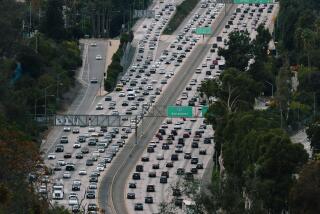First phase of 405 Freeway widening to move forward
- Share via
On a typical day, hundreds of thousands of commuters cram the 405 Freeway through the Sepulveda Pass, creating an unending line of taillights that snakes across the Santa Monica Mountains between the Westside and the San Fernando Valley.
For years, transportation officials have been pushing to ease the gridlock with a $1-billion widening project for the northbound 405 Freeway, which is considered one of the state’s most crowded highways. The project is supposed to move forward later this year, but the state’s grim financial situation may cause more delays.
The state had planned to sell $614 million in transportation bonds to help pay for its share of the project, but that has been delayed by the state’s fiscal crisis. It is unclear when the bonds will be sold.
In the meantime, the Metropolitan Transportation Authority is stepping in, allocating local and federal funds it had earmarked for the widening to get work started on the first phase.
Transportation officials have secured $372 million in funds, including $189.9 million from the federal stimulus package and $127.1 million in other federal funds.
The funds will allow work on the project for 15 months while officials seek further funding, said MTA spokesman Dave Sotero.
The MTA board of directors voted to move forward with the first phase of the project, which will include designing and relocating utilities that might impede in the widening of the freeway, as well as limited construction activity, Sotero said.
The plan calls for adding a carpool lane on a 10-mile stretch of the 405 northbound between the 10 and 101 freeways. The hope is that the lanes will encourage more people to ride-share, ultimately easing congestion in the area.
“There’s not a time of the day that the 405 doesn’t stop and go,” said Rick Thorpe, the MTA’s chief capital management officer. “Not everyone will be carpooling, but it’s a huge impact. . . . It will bring a tremendous improvement there.”
Sotero said MTA officials have been talking about various scenarios in the event that state funding is delayed for long periods of time. One idea is for the MTA to temporarily purchase the bonds and carry the debt.
The bonds have been caught in the state budget crisis as well as the nation’s credit crunch. But there are some signs that state bonds are beginning to be sold again.
State Treasurer Bill Locklyer recently announced the completion of a major general obligation bond sale that had been frozen because of the state’s fiscal problems.
“I’m cautiously optimistic,” Thorpe said, that “things will continue to improve and the state will issue the bonds as they have been.”
--
More to Read
Sign up for Essential California
The most important California stories and recommendations in your inbox every morning.
You may occasionally receive promotional content from the Los Angeles Times.










